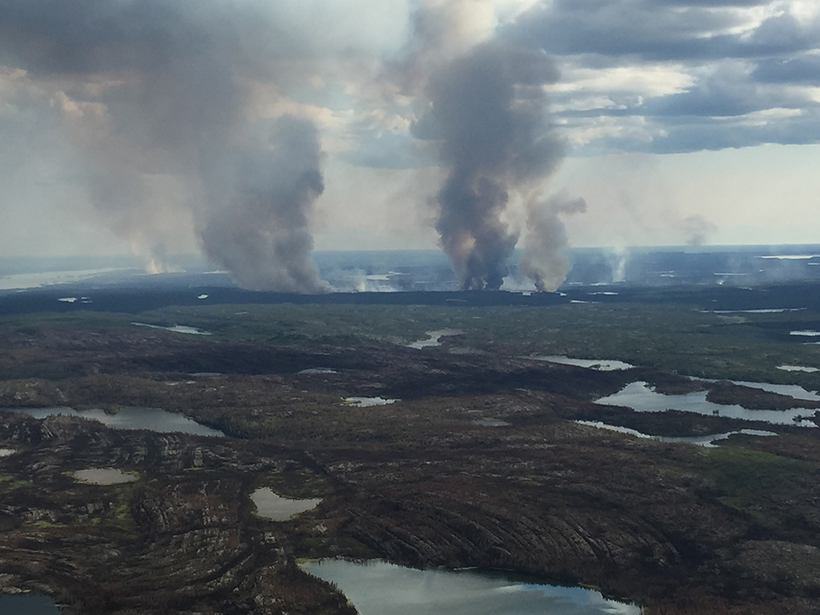
Wildfires burned more than 7,750 square kilometers of Alberta’s forests last year. New research indicates the conflagrations are part of a pattern showing increased average burned areas every year since 1970, and climate change is poised to accelerate this trend.
Ellen Whitman, a forest fire research scientist from Natural Resources Canada, used historical records as well as satellite data from the Landsat program to analyze how the frequency, size, and distribution of forest fires in the province of Alberta changed between 1970 and 2019—research she’ll present at AGU’s Fall Meeting 2020. She and coworkers from the Canadian Forest Service and the U.S. Forest Service found that forest fire activity in Alberta increased according to a plethora of metrics over the past 49 years, with the number of fires that consume at least 200 hectares of land almost doubling and the average area burned per year increasing approximately fifteenfold.
“Every variable we were interested in seems to have demonstrated some type of change over time,” Whitman said. Variables included data surrounding fires in wetlands and old-growth forests, as well as the recovery of forests after a fire.
Feedback Loops
Even wetlands, with their low propensity for fire, are burning more frequently. Whitman said that the proportion of burned wetland forests has increased approximately fivefold, from comprising only 3% of land burned by wildfires in 1970 to 15% in 2019.
Whitman documented a feedback loop between wetland fires and a warming climate. Increased fire activity correlated with increased temperature, as well as decreased precipitation and relative humidity—all hallmarks of climate change. These changes add up to a drier environment, and associated periodic drops in the water table allow even wetlands, which are typically associated with fire control, to burn.
The feedback loop incorporating wetland fires, the warming climate, and burn area is especially relevant to peat fires. As climate change increases the prevalence of peat fires, the loss of peat bogs could further accelerate climate change. These oxygen-poor accumulations of waterlogged vegetation compress carbon rather than degrade it, making them important carbon sinks. When they burn, carbon is released into the atmosphere, and the bogs become carbon sources.
“Carbon storage in those ecosystems took thousands of years to get to its current point. Now they can go up in smoke, or be released, in a matter of years.”
The Alberta study also showed that old-growth forests have also suffered from increased fire activity, and their demise could further accelerate climate change. “We’re seeing a shift toward more rapid growing, disturbance-favored species like aspen and Jack pine to the detriment of more long-lived and more carbon-storing species like white spruce and black spruce,” Whitman said.
Ernesto Alvarado is a forest ecologist at the University of Washington who said that Whitman’s work confirms a lot of what fire researchers have long suspected. He’s particularly concerned that increases in fire frequency and severity will reduce tree cover. In northern Canada, increased sunlight hitting the forest floor and wildfires could thaw permafrost, which locks carbon-storing soil under the forest floor.
“Carbon storage in those ecosystems took thousands of years to get to its current point,” Alvarado said. “Now they can go up in smoke, or be released, in a matter of years.”
Difficult Decisions
Historically, Canadians have assumed that forests will return to their original states after forest fires, Whitman said. But as fires intensify, forests are being pushed past their ability to adapt. In addition to accelerating climate change, long-term changes in tree cover could affect Canadians who rely on forests for resources like timber and fresh water. Increased fire activity also increases the vulnerability of communities in remote areas surrounded by forests.
Forestry managers may also find themselves faced with severe fires they’re unable to suppress or an overwhelming number of simultaneous fires. Already, some agencies are choosing which fires to fight on the basis of human safety, economics, and the ecological impact.
“We’re going to have to make some innovative and, I think, difficult decisions about how to manage fire and keep people safe,” Whitman said.
—Saima Sidik (@saimamaysidik), Science Writer
Citation:
Sidik, S. (2020), Feedback loops of fire activity and climate change in Canada, Eos, 101, https://doi.org/10.1029/2020EO152247. Published on 08 December 2020.
Text © 2020. The authors. CC BY-NC-ND 3.0
Except where otherwise noted, images are subject to copyright. Any reuse without express permission from the copyright owner is prohibited.

